University Case Study Analysis: Palliative Care for Elderly Patient
VerifiedAdded on 2022/10/18
|11
|2503
|6
Homework Assignment
AI Summary
This assignment presents a detailed analysis of a palliative care case study involving an 82-year-old patient named Ramesh, focusing on his physical, emotional, and spiritual needs. The analysis addresses various aspects of holistic assessment, including pain management strategies (pharmacological and psychological), ethical considerations, and communication techniques. It explores the pathophysiology of gastric carcinoma, the patient's primary needs (comfort care), and the roles of nurses and the multidisciplinary team. The assignment also covers support services for the patient and family, including bereavement care, and the ethical implications of advanced care planning. The document emphasizes the importance of respecting patient autonomy, managing symptoms, and providing culturally sensitive care. It also explores the challenges families face, the stages of dying, and the role of self-care for healthcare professionals. The assignment concludes with discussions on ethical dilemmas, documentation, and post-death care, providing a comprehensive overview of palliative care principles and practices.
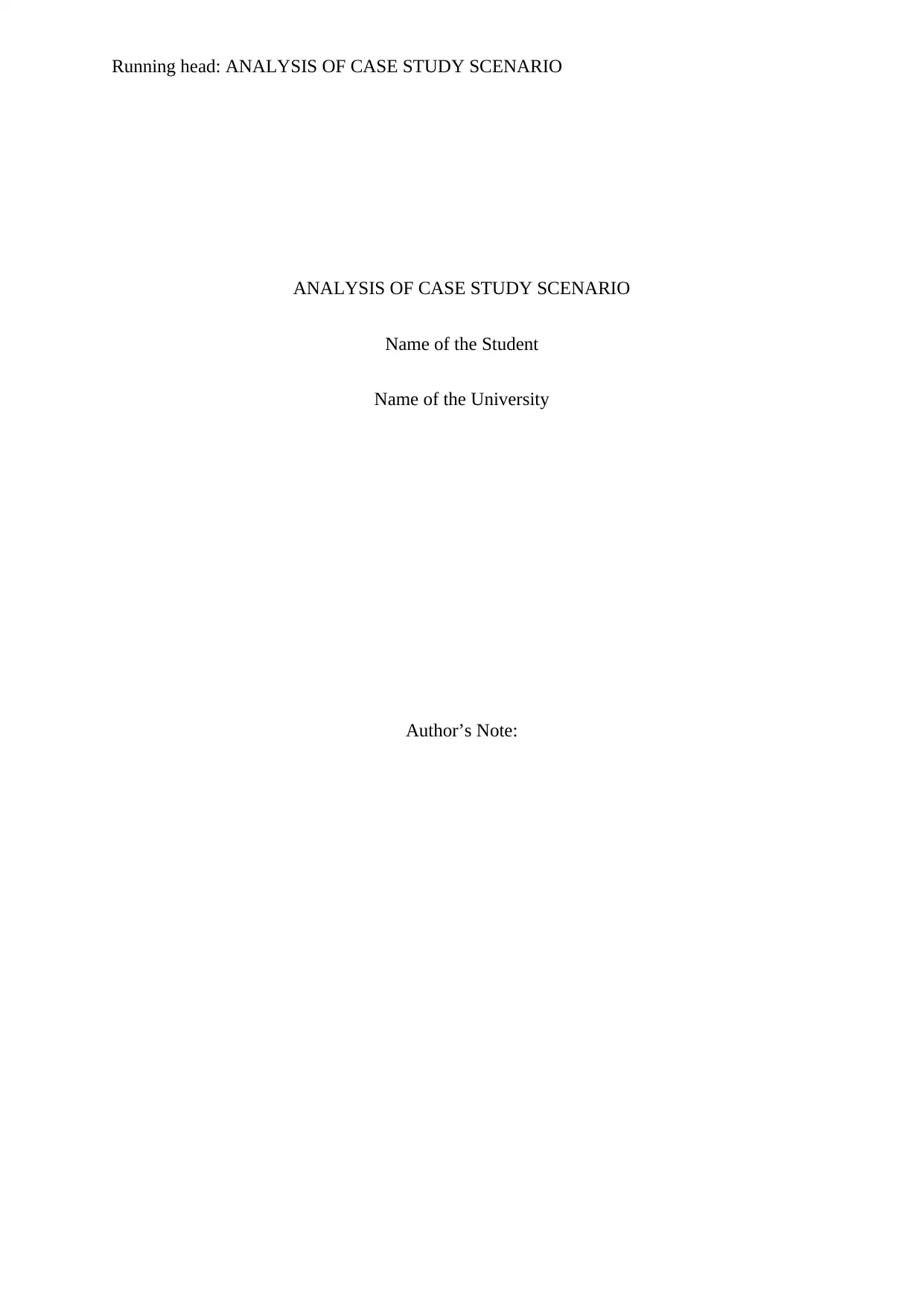
Running head: ANALYSIS OF CASE STUDY SCENARIO
ANALYSIS OF CASE STUDY SCENARIO
Name of the Student
Name of the University
Author’s Note:
ANALYSIS OF CASE STUDY SCENARIO
Name of the Student
Name of the University
Author’s Note:
Paraphrase This Document
Need a fresh take? Get an instant paraphrase of this document with our AI Paraphraser
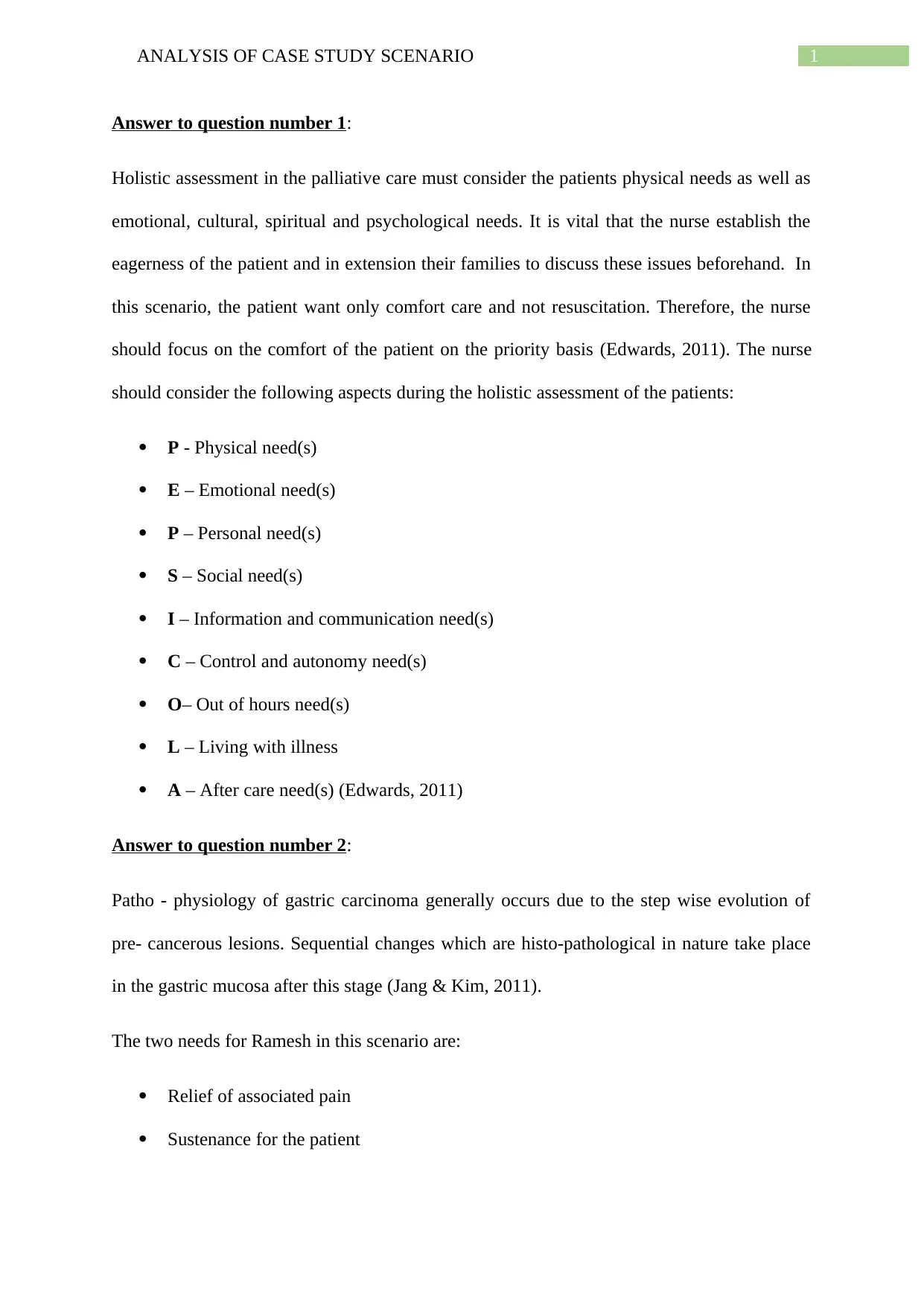
1ANALYSIS OF CASE STUDY SCENARIO
Answer to question number 1:
Holistic assessment in the palliative care must consider the patients physical needs as well as
emotional, cultural, spiritual and psychological needs. It is vital that the nurse establish the
eagerness of the patient and in extension their families to discuss these issues beforehand. In
this scenario, the patient want only comfort care and not resuscitation. Therefore, the nurse
should focus on the comfort of the patient on the priority basis (Edwards, 2011). The nurse
should consider the following aspects during the holistic assessment of the patients:
P - Physical need(s)
E – Emotional need(s)
P – Personal need(s)
S – Social need(s)
I – Information and communication need(s)
C – Control and autonomy need(s)
O– Out of hours need(s)
L – Living with illness
A – After care need(s) (Edwards, 2011)
Answer to question number 2:
Patho - physiology of gastric carcinoma generally occurs due to the step wise evolution of
pre- cancerous lesions. Sequential changes which are histo-pathological in nature take place
in the gastric mucosa after this stage (Jang & Kim, 2011).
The two needs for Ramesh in this scenario are:
Relief of associated pain
Sustenance for the patient
Answer to question number 1:
Holistic assessment in the palliative care must consider the patients physical needs as well as
emotional, cultural, spiritual and psychological needs. It is vital that the nurse establish the
eagerness of the patient and in extension their families to discuss these issues beforehand. In
this scenario, the patient want only comfort care and not resuscitation. Therefore, the nurse
should focus on the comfort of the patient on the priority basis (Edwards, 2011). The nurse
should consider the following aspects during the holistic assessment of the patients:
P - Physical need(s)
E – Emotional need(s)
P – Personal need(s)
S – Social need(s)
I – Information and communication need(s)
C – Control and autonomy need(s)
O– Out of hours need(s)
L – Living with illness
A – After care need(s) (Edwards, 2011)
Answer to question number 2:
Patho - physiology of gastric carcinoma generally occurs due to the step wise evolution of
pre- cancerous lesions. Sequential changes which are histo-pathological in nature take place
in the gastric mucosa after this stage (Jang & Kim, 2011).
The two needs for Ramesh in this scenario are:
Relief of associated pain
Sustenance for the patient
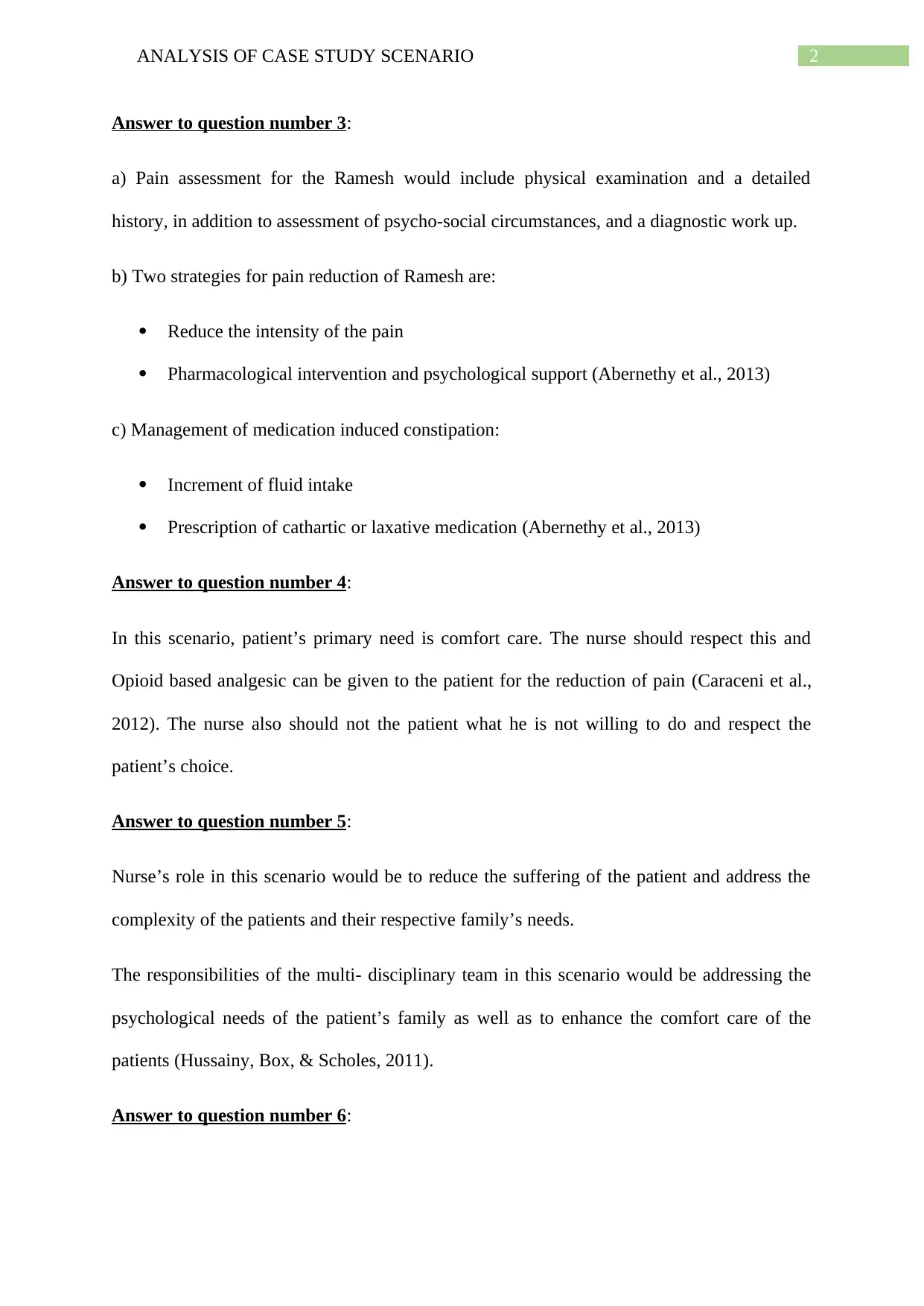
2ANALYSIS OF CASE STUDY SCENARIO
Answer to question number 3:
a) Pain assessment for the Ramesh would include physical examination and a detailed
history, in addition to assessment of psycho-social circumstances, and a diagnostic work up.
b) Two strategies for pain reduction of Ramesh are:
Reduce the intensity of the pain
Pharmacological intervention and psychological support (Abernethy et al., 2013)
c) Management of medication induced constipation:
Increment of fluid intake
Prescription of cathartic or laxative medication (Abernethy et al., 2013)
Answer to question number 4:
In this scenario, patient’s primary need is comfort care. The nurse should respect this and
Opioid based analgesic can be given to the patient for the reduction of pain (Caraceni et al.,
2012). The nurse also should not the patient what he is not willing to do and respect the
patient’s choice.
Answer to question number 5:
Nurse’s role in this scenario would be to reduce the suffering of the patient and address the
complexity of the patients and their respective family’s needs.
The responsibilities of the multi- disciplinary team in this scenario would be addressing the
psychological needs of the patient’s family as well as to enhance the comfort care of the
patients (Hussainy, Box, & Scholes, 2011).
Answer to question number 6:
Answer to question number 3:
a) Pain assessment for the Ramesh would include physical examination and a detailed
history, in addition to assessment of psycho-social circumstances, and a diagnostic work up.
b) Two strategies for pain reduction of Ramesh are:
Reduce the intensity of the pain
Pharmacological intervention and psychological support (Abernethy et al., 2013)
c) Management of medication induced constipation:
Increment of fluid intake
Prescription of cathartic or laxative medication (Abernethy et al., 2013)
Answer to question number 4:
In this scenario, patient’s primary need is comfort care. The nurse should respect this and
Opioid based analgesic can be given to the patient for the reduction of pain (Caraceni et al.,
2012). The nurse also should not the patient what he is not willing to do and respect the
patient’s choice.
Answer to question number 5:
Nurse’s role in this scenario would be to reduce the suffering of the patient and address the
complexity of the patients and their respective family’s needs.
The responsibilities of the multi- disciplinary team in this scenario would be addressing the
psychological needs of the patient’s family as well as to enhance the comfort care of the
patients (Hussainy, Box, & Scholes, 2011).
Answer to question number 6:
⊘ This is a preview!⊘
Do you want full access?
Subscribe today to unlock all pages.

Trusted by 1+ million students worldwide
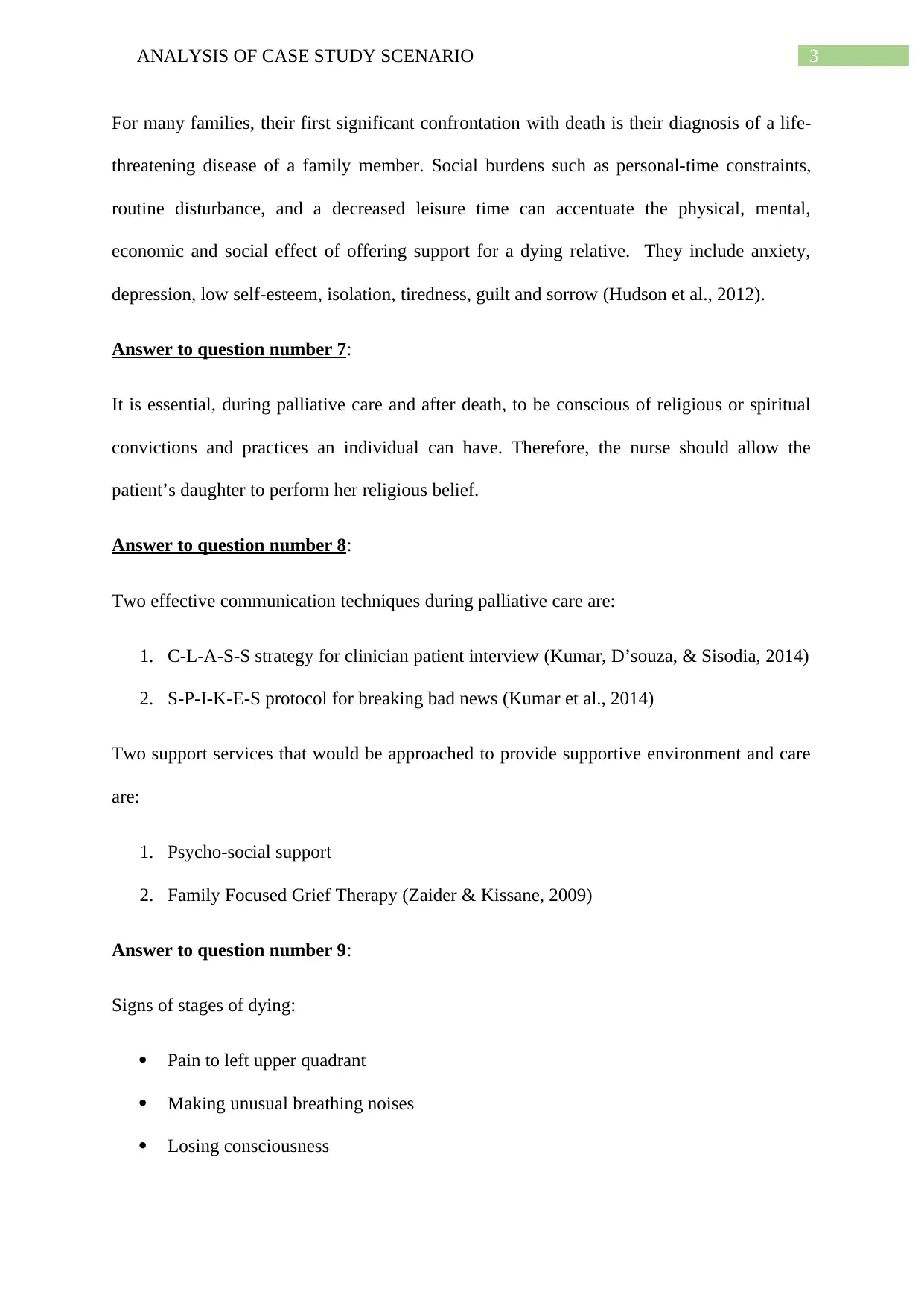
3ANALYSIS OF CASE STUDY SCENARIO
For many families, their first significant confrontation with death is their diagnosis of a life-
threatening disease of a family member. Social burdens such as personal-time constraints,
routine disturbance, and a decreased leisure time can accentuate the physical, mental,
economic and social effect of offering support for a dying relative. They include anxiety,
depression, low self-esteem, isolation, tiredness, guilt and sorrow (Hudson et al., 2012).
Answer to question number 7:
It is essential, during palliative care and after death, to be conscious of religious or spiritual
convictions and practices an individual can have. Therefore, the nurse should allow the
patient’s daughter to perform her religious belief.
Answer to question number 8:
Two effective communication techniques during palliative care are:
1. C-L-A-S-S strategy for clinician patient interview (Kumar, D’souza, & Sisodia, 2014)
2. S-P-I-K-E-S protocol for breaking bad news (Kumar et al., 2014)
Two support services that would be approached to provide supportive environment and care
are:
1. Psycho-social support
2. Family Focused Grief Therapy (Zaider & Kissane, 2009)
Answer to question number 9:
Signs of stages of dying:
Pain to left upper quadrant
Making unusual breathing noises
Losing consciousness
For many families, their first significant confrontation with death is their diagnosis of a life-
threatening disease of a family member. Social burdens such as personal-time constraints,
routine disturbance, and a decreased leisure time can accentuate the physical, mental,
economic and social effect of offering support for a dying relative. They include anxiety,
depression, low self-esteem, isolation, tiredness, guilt and sorrow (Hudson et al., 2012).
Answer to question number 7:
It is essential, during palliative care and after death, to be conscious of religious or spiritual
convictions and practices an individual can have. Therefore, the nurse should allow the
patient’s daughter to perform her religious belief.
Answer to question number 8:
Two effective communication techniques during palliative care are:
1. C-L-A-S-S strategy for clinician patient interview (Kumar, D’souza, & Sisodia, 2014)
2. S-P-I-K-E-S protocol for breaking bad news (Kumar et al., 2014)
Two support services that would be approached to provide supportive environment and care
are:
1. Psycho-social support
2. Family Focused Grief Therapy (Zaider & Kissane, 2009)
Answer to question number 9:
Signs of stages of dying:
Pain to left upper quadrant
Making unusual breathing noises
Losing consciousness
Paraphrase This Document
Need a fresh take? Get an instant paraphrase of this document with our AI Paraphraser
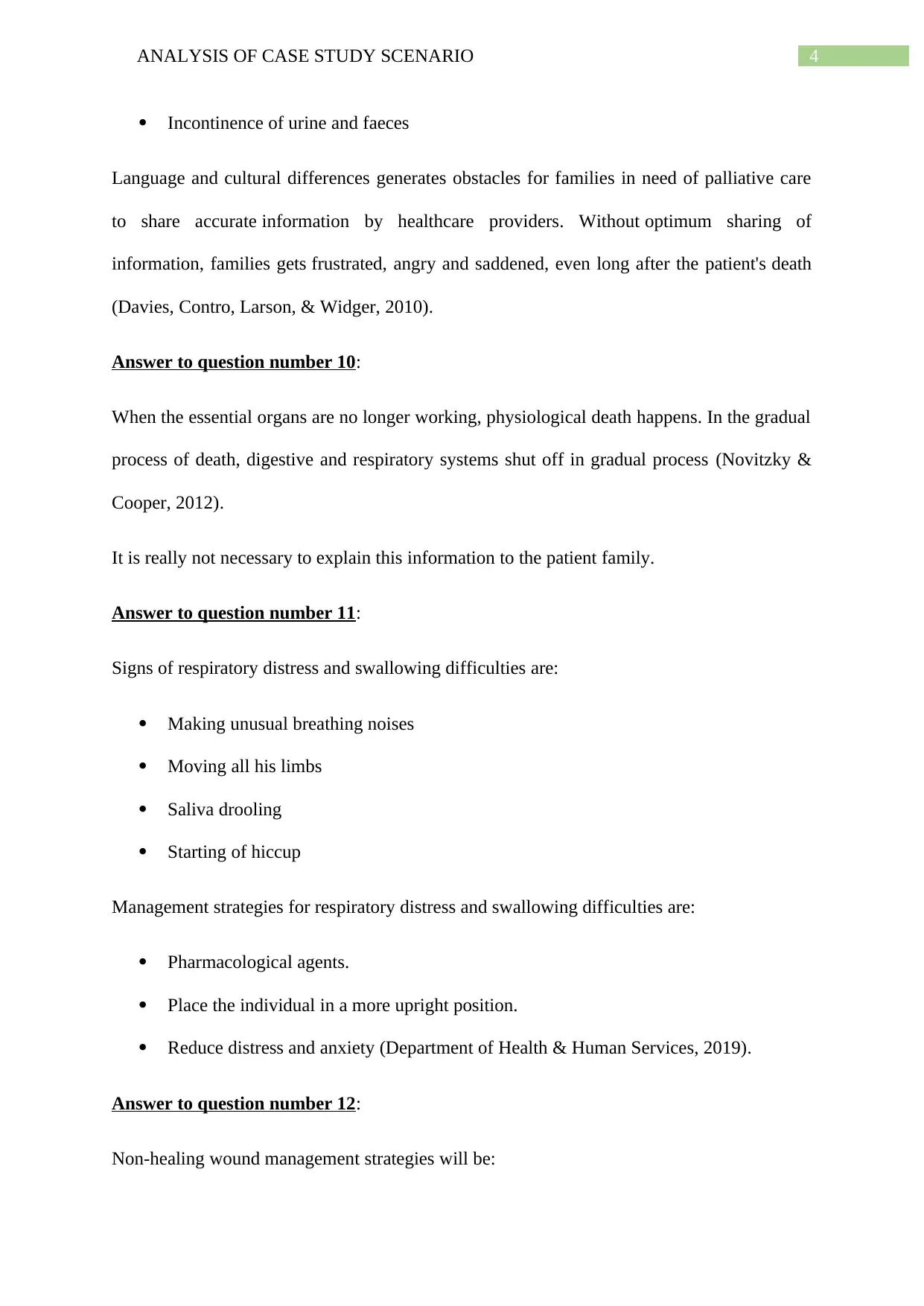
4ANALYSIS OF CASE STUDY SCENARIO
Incontinence of urine and faeces
Language and cultural differences generates obstacles for families in need of palliative care
to share accurate information by healthcare providers. Without optimum sharing of
information, families gets frustrated, angry and saddened, even long after the patient's death
(Davies, Contro, Larson, & Widger, 2010).
Answer to question number 10:
When the essential organs are no longer working, physiological death happens. In the gradual
process of death, digestive and respiratory systems shut off in gradual process (Novitzky &
Cooper, 2012).
It is really not necessary to explain this information to the patient family.
Answer to question number 11:
Signs of respiratory distress and swallowing difficulties are:
Making unusual breathing noises
Moving all his limbs
Saliva drooling
Starting of hiccup
Management strategies for respiratory distress and swallowing difficulties are:
Pharmacological agents.
Place the individual in a more upright position.
Reduce distress and anxiety (Department of Health & Human Services, 2019).
Answer to question number 12:
Non-healing wound management strategies will be:
Incontinence of urine and faeces
Language and cultural differences generates obstacles for families in need of palliative care
to share accurate information by healthcare providers. Without optimum sharing of
information, families gets frustrated, angry and saddened, even long after the patient's death
(Davies, Contro, Larson, & Widger, 2010).
Answer to question number 10:
When the essential organs are no longer working, physiological death happens. In the gradual
process of death, digestive and respiratory systems shut off in gradual process (Novitzky &
Cooper, 2012).
It is really not necessary to explain this information to the patient family.
Answer to question number 11:
Signs of respiratory distress and swallowing difficulties are:
Making unusual breathing noises
Moving all his limbs
Saliva drooling
Starting of hiccup
Management strategies for respiratory distress and swallowing difficulties are:
Pharmacological agents.
Place the individual in a more upright position.
Reduce distress and anxiety (Department of Health & Human Services, 2019).
Answer to question number 12:
Non-healing wound management strategies will be:
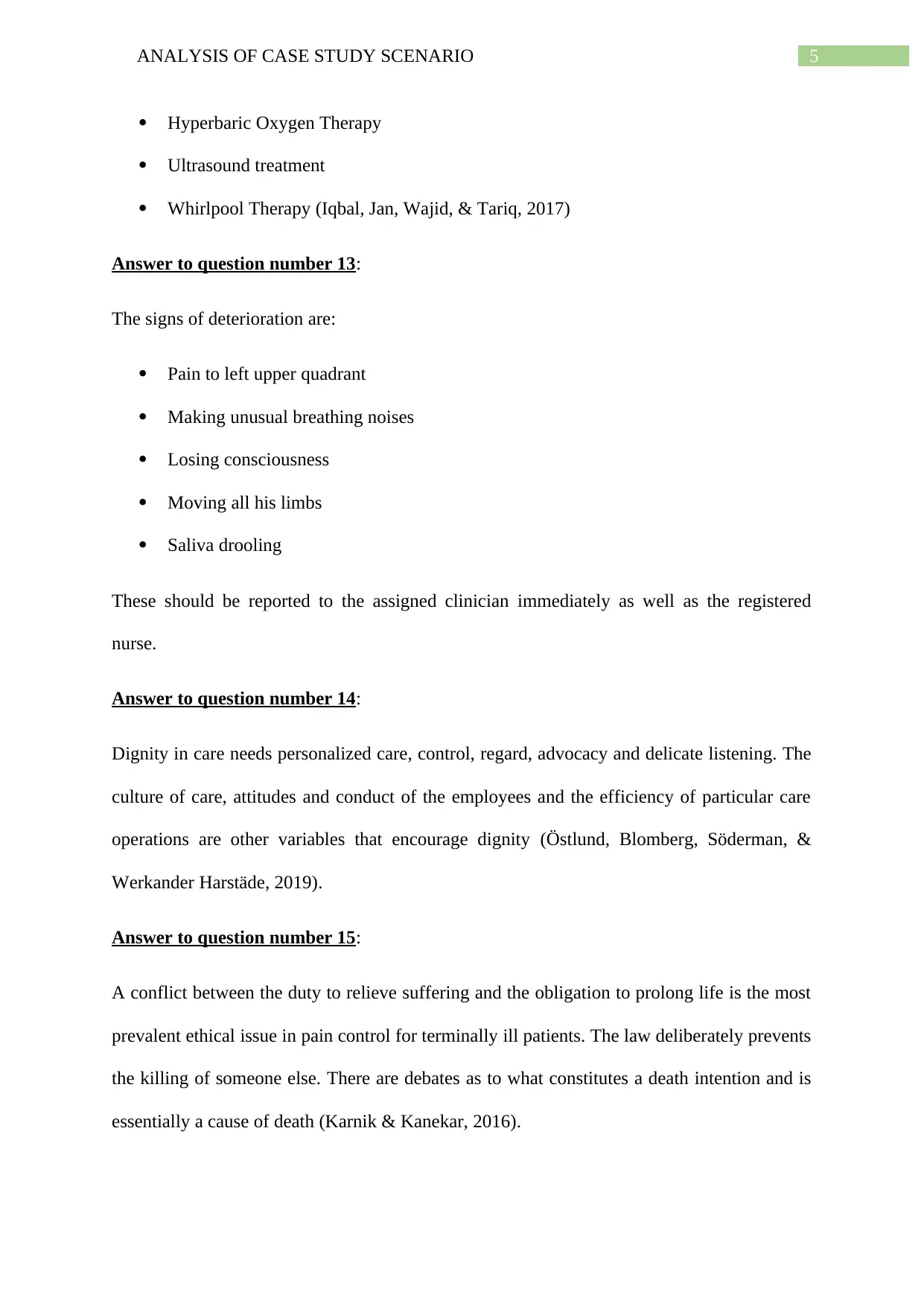
5ANALYSIS OF CASE STUDY SCENARIO
Hyperbaric Oxygen Therapy
Ultrasound treatment
Whirlpool Therapy (Iqbal, Jan, Wajid, & Tariq, 2017)
Answer to question number 13:
The signs of deterioration are:
Pain to left upper quadrant
Making unusual breathing noises
Losing consciousness
Moving all his limbs
Saliva drooling
These should be reported to the assigned clinician immediately as well as the registered
nurse.
Answer to question number 14:
Dignity in care needs personalized care, control, regard, advocacy and delicate listening. The
culture of care, attitudes and conduct of the employees and the efficiency of particular care
operations are other variables that encourage dignity (Östlund, Blomberg, Söderman, &
Werkander Harstäde, 2019).
Answer to question number 15:
A conflict between the duty to relieve suffering and the obligation to prolong life is the most
prevalent ethical issue in pain control for terminally ill patients. The law deliberately prevents
the killing of someone else. There are debates as to what constitutes a death intention and is
essentially a cause of death (Karnik & Kanekar, 2016).
Hyperbaric Oxygen Therapy
Ultrasound treatment
Whirlpool Therapy (Iqbal, Jan, Wajid, & Tariq, 2017)
Answer to question number 13:
The signs of deterioration are:
Pain to left upper quadrant
Making unusual breathing noises
Losing consciousness
Moving all his limbs
Saliva drooling
These should be reported to the assigned clinician immediately as well as the registered
nurse.
Answer to question number 14:
Dignity in care needs personalized care, control, regard, advocacy and delicate listening. The
culture of care, attitudes and conduct of the employees and the efficiency of particular care
operations are other variables that encourage dignity (Östlund, Blomberg, Söderman, &
Werkander Harstäde, 2019).
Answer to question number 15:
A conflict between the duty to relieve suffering and the obligation to prolong life is the most
prevalent ethical issue in pain control for terminally ill patients. The law deliberately prevents
the killing of someone else. There are debates as to what constitutes a death intention and is
essentially a cause of death (Karnik & Kanekar, 2016).
⊘ This is a preview!⊘
Do you want full access?
Subscribe today to unlock all pages.

Trusted by 1+ million students worldwide
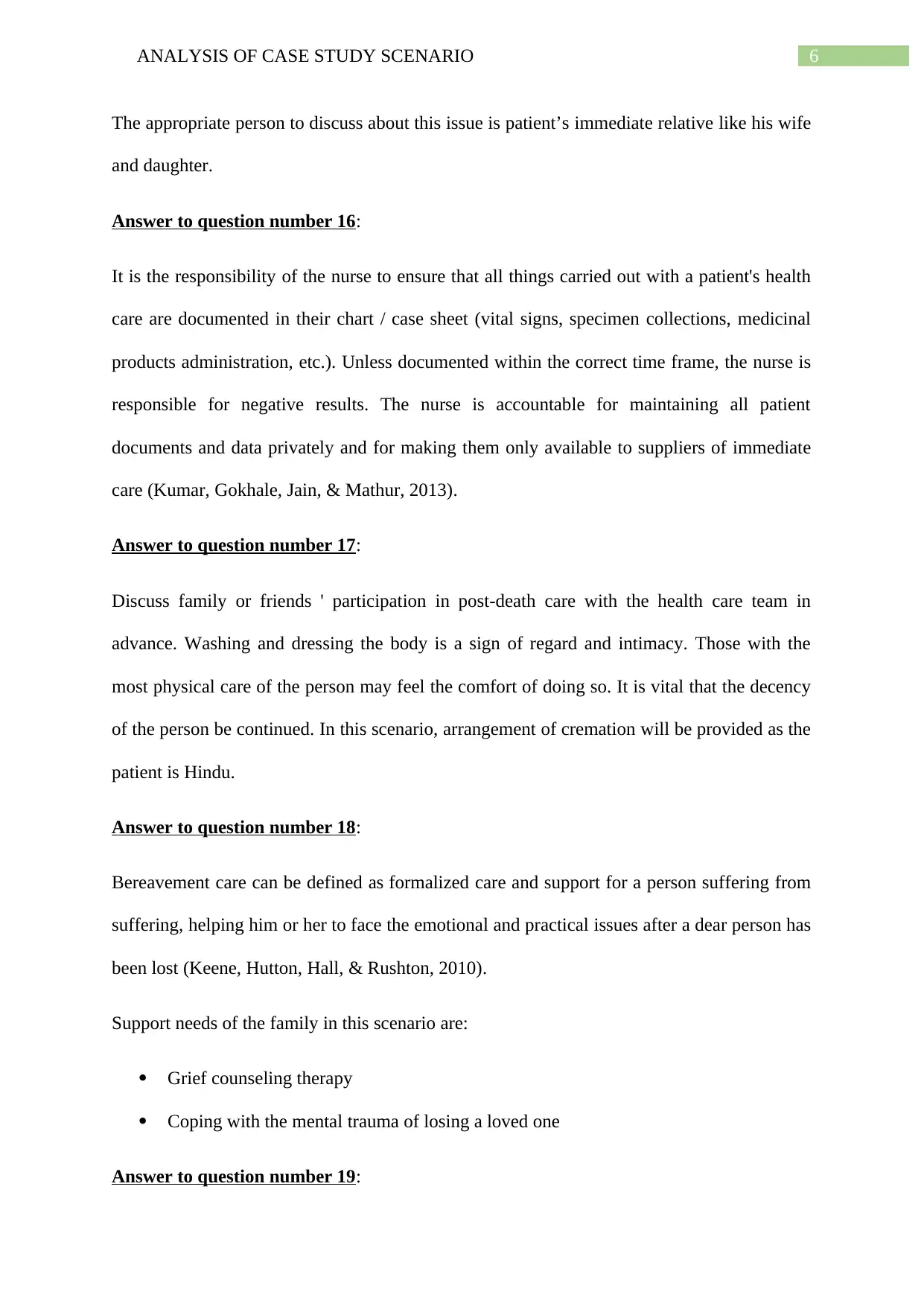
6ANALYSIS OF CASE STUDY SCENARIO
The appropriate person to discuss about this issue is patient’s immediate relative like his wife
and daughter.
Answer to question number 16:
It is the responsibility of the nurse to ensure that all things carried out with a patient's health
care are documented in their chart / case sheet (vital signs, specimen collections, medicinal
products administration, etc.). Unless documented within the correct time frame, the nurse is
responsible for negative results. The nurse is accountable for maintaining all patient
documents and data privately and for making them only available to suppliers of immediate
care (Kumar, Gokhale, Jain, & Mathur, 2013).
Answer to question number 17:
Discuss family or friends ' participation in post-death care with the health care team in
advance. Washing and dressing the body is a sign of regard and intimacy. Those with the
most physical care of the person may feel the comfort of doing so. It is vital that the decency
of the person be continued. In this scenario, arrangement of cremation will be provided as the
patient is Hindu.
Answer to question number 18:
Bereavement care can be defined as formalized care and support for a person suffering from
suffering, helping him or her to face the emotional and practical issues after a dear person has
been lost (Keene, Hutton, Hall, & Rushton, 2010).
Support needs of the family in this scenario are:
Grief counseling therapy
Coping with the mental trauma of losing a loved one
Answer to question number 19:
The appropriate person to discuss about this issue is patient’s immediate relative like his wife
and daughter.
Answer to question number 16:
It is the responsibility of the nurse to ensure that all things carried out with a patient's health
care are documented in their chart / case sheet (vital signs, specimen collections, medicinal
products administration, etc.). Unless documented within the correct time frame, the nurse is
responsible for negative results. The nurse is accountable for maintaining all patient
documents and data privately and for making them only available to suppliers of immediate
care (Kumar, Gokhale, Jain, & Mathur, 2013).
Answer to question number 17:
Discuss family or friends ' participation in post-death care with the health care team in
advance. Washing and dressing the body is a sign of regard and intimacy. Those with the
most physical care of the person may feel the comfort of doing so. It is vital that the decency
of the person be continued. In this scenario, arrangement of cremation will be provided as the
patient is Hindu.
Answer to question number 18:
Bereavement care can be defined as formalized care and support for a person suffering from
suffering, helping him or her to face the emotional and practical issues after a dear person has
been lost (Keene, Hutton, Hall, & Rushton, 2010).
Support needs of the family in this scenario are:
Grief counseling therapy
Coping with the mental trauma of losing a loved one
Answer to question number 19:
Paraphrase This Document
Need a fresh take? Get an instant paraphrase of this document with our AI Paraphraser
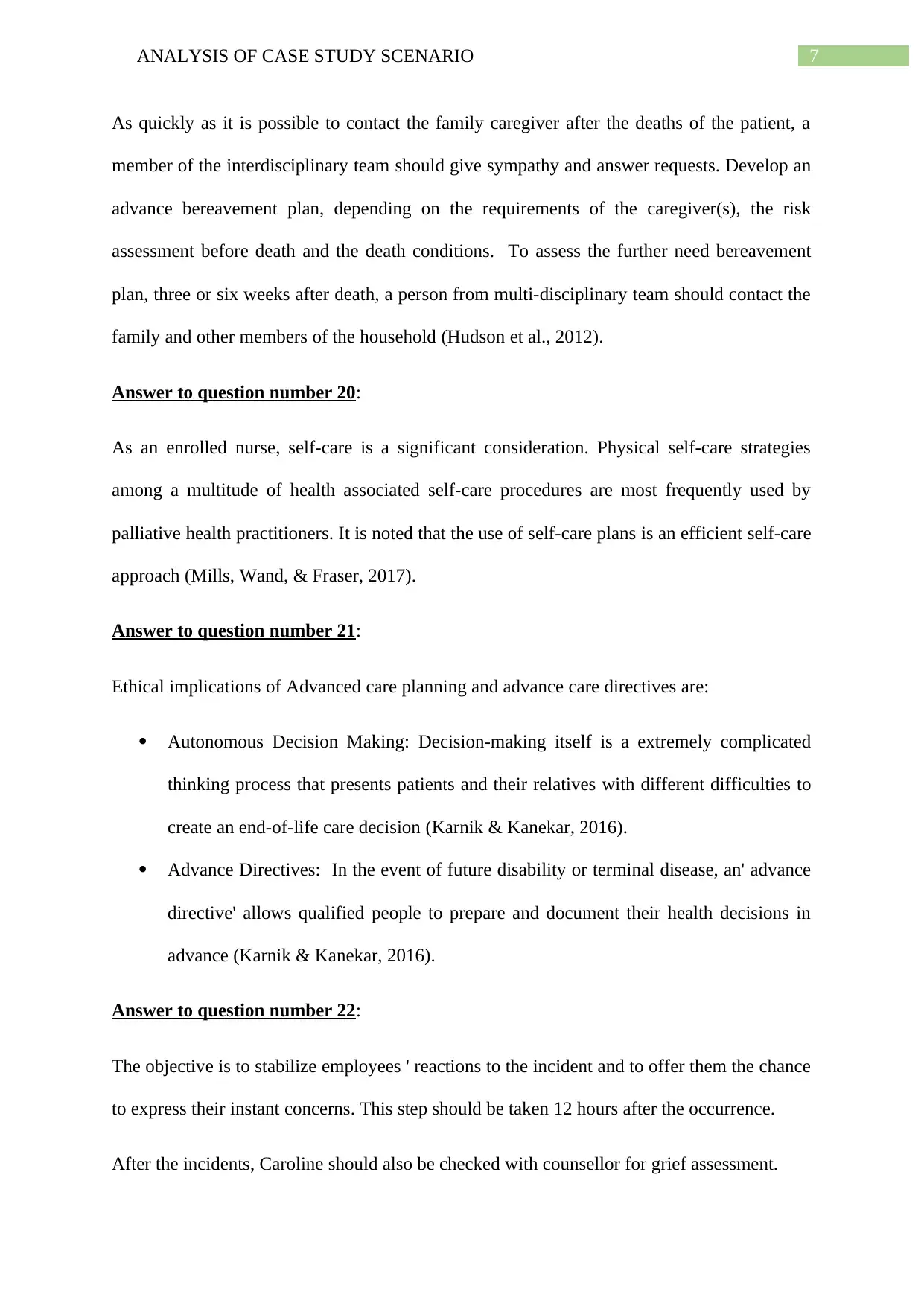
7ANALYSIS OF CASE STUDY SCENARIO
As quickly as it is possible to contact the family caregiver after the deaths of the patient, a
member of the interdisciplinary team should give sympathy and answer requests. Develop an
advance bereavement plan, depending on the requirements of the caregiver(s), the risk
assessment before death and the death conditions. To assess the further need bereavement
plan, three or six weeks after death, a person from multi-disciplinary team should contact the
family and other members of the household (Hudson et al., 2012).
Answer to question number 20:
As an enrolled nurse, self-care is a significant consideration. Physical self-care strategies
among a multitude of health associated self-care procedures are most frequently used by
palliative health practitioners. It is noted that the use of self-care plans is an efficient self-care
approach (Mills, Wand, & Fraser, 2017).
Answer to question number 21:
Ethical implications of Advanced care planning and advance care directives are:
Autonomous Decision Making: Decision-making itself is a extremely complicated
thinking process that presents patients and their relatives with different difficulties to
create an end-of-life care decision (Karnik & Kanekar, 2016).
Advance Directives: In the event of future disability or terminal disease, an' advance
directive' allows qualified people to prepare and document their health decisions in
advance (Karnik & Kanekar, 2016).
Answer to question number 22:
The objective is to stabilize employees ' reactions to the incident and to offer them the chance
to express their instant concerns. This step should be taken 12 hours after the occurrence.
After the incidents, Caroline should also be checked with counsellor for grief assessment.
As quickly as it is possible to contact the family caregiver after the deaths of the patient, a
member of the interdisciplinary team should give sympathy and answer requests. Develop an
advance bereavement plan, depending on the requirements of the caregiver(s), the risk
assessment before death and the death conditions. To assess the further need bereavement
plan, three or six weeks after death, a person from multi-disciplinary team should contact the
family and other members of the household (Hudson et al., 2012).
Answer to question number 20:
As an enrolled nurse, self-care is a significant consideration. Physical self-care strategies
among a multitude of health associated self-care procedures are most frequently used by
palliative health practitioners. It is noted that the use of self-care plans is an efficient self-care
approach (Mills, Wand, & Fraser, 2017).
Answer to question number 21:
Ethical implications of Advanced care planning and advance care directives are:
Autonomous Decision Making: Decision-making itself is a extremely complicated
thinking process that presents patients and their relatives with different difficulties to
create an end-of-life care decision (Karnik & Kanekar, 2016).
Advance Directives: In the event of future disability or terminal disease, an' advance
directive' allows qualified people to prepare and document their health decisions in
advance (Karnik & Kanekar, 2016).
Answer to question number 22:
The objective is to stabilize employees ' reactions to the incident and to offer them the chance
to express their instant concerns. This step should be taken 12 hours after the occurrence.
After the incidents, Caroline should also be checked with counsellor for grief assessment.
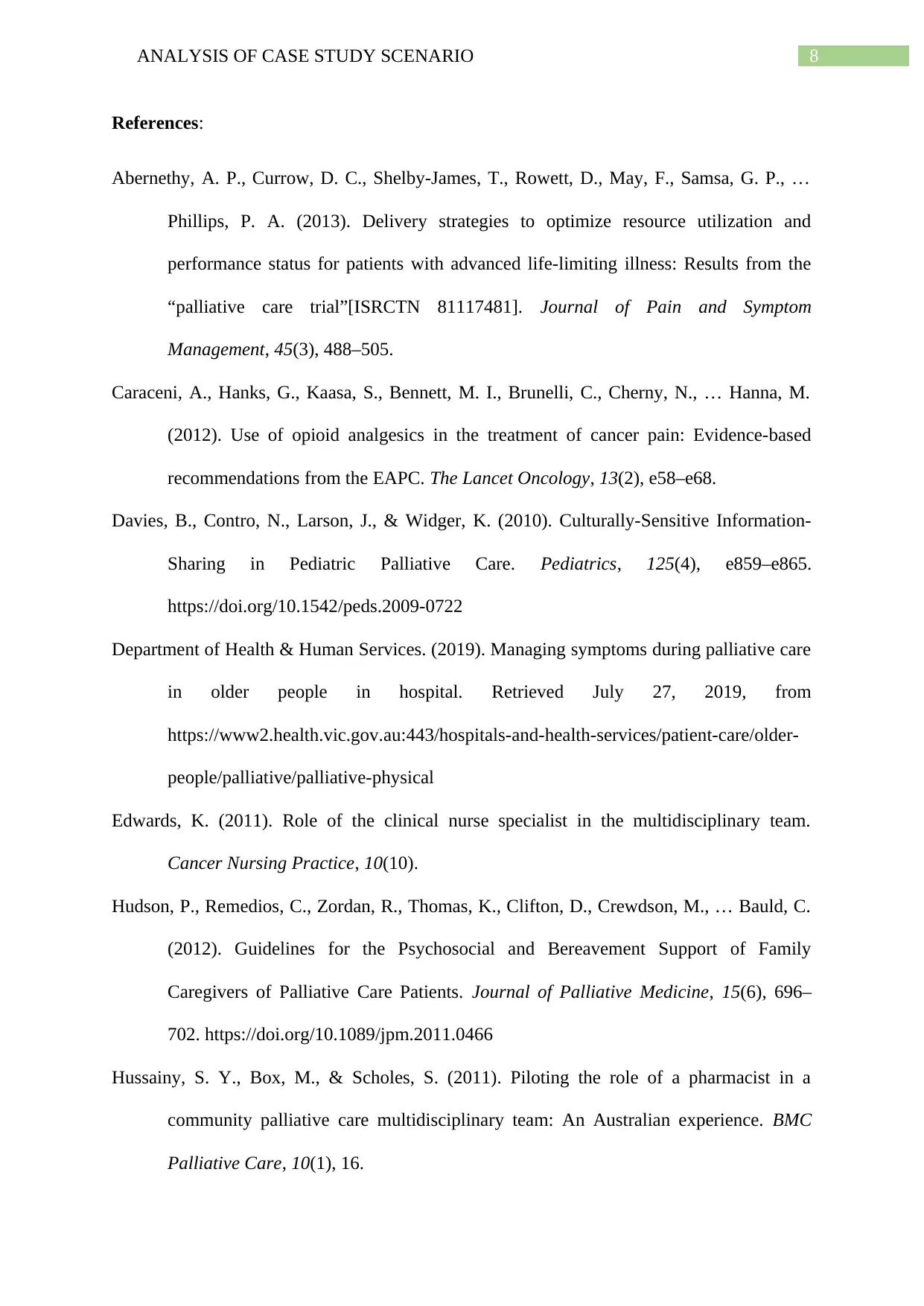
8ANALYSIS OF CASE STUDY SCENARIO
References:
Abernethy, A. P., Currow, D. C., Shelby-James, T., Rowett, D., May, F., Samsa, G. P., …
Phillips, P. A. (2013). Delivery strategies to optimize resource utilization and
performance status for patients with advanced life-limiting illness: Results from the
“palliative care trial”[ISRCTN 81117481]. Journal of Pain and Symptom
Management, 45(3), 488–505.
Caraceni, A., Hanks, G., Kaasa, S., Bennett, M. I., Brunelli, C., Cherny, N., … Hanna, M.
(2012). Use of opioid analgesics in the treatment of cancer pain: Evidence-based
recommendations from the EAPC. The Lancet Oncology, 13(2), e58–e68.
Davies, B., Contro, N., Larson, J., & Widger, K. (2010). Culturally-Sensitive Information-
Sharing in Pediatric Palliative Care. Pediatrics, 125(4), e859–e865.
https://doi.org/10.1542/peds.2009-0722
Department of Health & Human Services. (2019). Managing symptoms during palliative care
in older people in hospital. Retrieved July 27, 2019, from
https://www2.health.vic.gov.au:443/hospitals-and-health-services/patient-care/older-
people/palliative/palliative-physical
Edwards, K. (2011). Role of the clinical nurse specialist in the multidisciplinary team.
Cancer Nursing Practice, 10(10).
Hudson, P., Remedios, C., Zordan, R., Thomas, K., Clifton, D., Crewdson, M., … Bauld, C.
(2012). Guidelines for the Psychosocial and Bereavement Support of Family
Caregivers of Palliative Care Patients. Journal of Palliative Medicine, 15(6), 696–
702. https://doi.org/10.1089/jpm.2011.0466
Hussainy, S. Y., Box, M., & Scholes, S. (2011). Piloting the role of a pharmacist in a
community palliative care multidisciplinary team: An Australian experience. BMC
Palliative Care, 10(1), 16.
References:
Abernethy, A. P., Currow, D. C., Shelby-James, T., Rowett, D., May, F., Samsa, G. P., …
Phillips, P. A. (2013). Delivery strategies to optimize resource utilization and
performance status for patients with advanced life-limiting illness: Results from the
“palliative care trial”[ISRCTN 81117481]. Journal of Pain and Symptom
Management, 45(3), 488–505.
Caraceni, A., Hanks, G., Kaasa, S., Bennett, M. I., Brunelli, C., Cherny, N., … Hanna, M.
(2012). Use of opioid analgesics in the treatment of cancer pain: Evidence-based
recommendations from the EAPC. The Lancet Oncology, 13(2), e58–e68.
Davies, B., Contro, N., Larson, J., & Widger, K. (2010). Culturally-Sensitive Information-
Sharing in Pediatric Palliative Care. Pediatrics, 125(4), e859–e865.
https://doi.org/10.1542/peds.2009-0722
Department of Health & Human Services. (2019). Managing symptoms during palliative care
in older people in hospital. Retrieved July 27, 2019, from
https://www2.health.vic.gov.au:443/hospitals-and-health-services/patient-care/older-
people/palliative/palliative-physical
Edwards, K. (2011). Role of the clinical nurse specialist in the multidisciplinary team.
Cancer Nursing Practice, 10(10).
Hudson, P., Remedios, C., Zordan, R., Thomas, K., Clifton, D., Crewdson, M., … Bauld, C.
(2012). Guidelines for the Psychosocial and Bereavement Support of Family
Caregivers of Palliative Care Patients. Journal of Palliative Medicine, 15(6), 696–
702. https://doi.org/10.1089/jpm.2011.0466
Hussainy, S. Y., Box, M., & Scholes, S. (2011). Piloting the role of a pharmacist in a
community palliative care multidisciplinary team: An Australian experience. BMC
Palliative Care, 10(1), 16.
⊘ This is a preview!⊘
Do you want full access?
Subscribe today to unlock all pages.

Trusted by 1+ million students worldwide

9ANALYSIS OF CASE STUDY SCENARIO
Iqbal, A., Jan, A., Wajid, M., & Tariq, S. (2017). Management of Chronic Non-healing
Wounds by Hirudotherapy. World Journal of Plastic Surgery, 6(1), 9–17.
Jang, B.-G., & Kim, W. H. (2011). Molecular pathology of gastric carcinoma. Pathobiology,
78(6), 302–310.
Karnik, S., & Kanekar, A. (2016). Ethical Issues Surrounding End-of-Life Care: A Narrative
Review. Healthcare, 4(2). https://doi.org/10.3390/healthcare4020024
Keene, E. A., Hutton, N., Hall, B., & Rushton, C. (2010). Bereavement debriefing sessions:
An intervention to support health care professionals in managing their grief after the
death of a patient. Pediatric Nursing, 36(4).
Kumar, H., Gokhale, Jain, K., & Mathur, D. R. (2013). Legal Awareness and Responsibilities
of Nursing Staff in Administration of Patient Care in A Trust Hospital. Journal of
Clinical and Diagnostic Research : JCDR, 7(12), 2814–2817.
https://doi.org/10.7860/JCDR/2013/7737.3886
Kumar, S. P., D’souza, M., & Sisodia, V. (2014). Interpersonal Communication Skills and
Palliative Care: “Finding the Story Behind the Story.” Indian Journal of Palliative
Care, 20(1), 62–64. https://doi.org/10.4103/0973-1075.125571
Mills, J., Wand, T., & Fraser, J. A. (2017). Self-Care in Palliative Care Nursing and Medical
Professionals: A Cross-Sectional Survey. Journal of Palliative Medicine, 20(6), 625–
630. https://doi.org/10.1089/jpm.2016.0470
Novitzky, D., & Cooper, D. K. (2012). The brain-dead organ donor: Pathophysiology and
management. Springer Science & Business Media.
Östlund, U., Blomberg, K., Söderman, A., & Werkander Harstäde, C. (2019). How to
conserve dignity in palliative care: Suggestions from older patients, significant others,
and healthcare professionals in Swedish municipal care. BMC Palliative Care, 18(1),
10. https://doi.org/10.1186/s12904-019-0393-x
Iqbal, A., Jan, A., Wajid, M., & Tariq, S. (2017). Management of Chronic Non-healing
Wounds by Hirudotherapy. World Journal of Plastic Surgery, 6(1), 9–17.
Jang, B.-G., & Kim, W. H. (2011). Molecular pathology of gastric carcinoma. Pathobiology,
78(6), 302–310.
Karnik, S., & Kanekar, A. (2016). Ethical Issues Surrounding End-of-Life Care: A Narrative
Review. Healthcare, 4(2). https://doi.org/10.3390/healthcare4020024
Keene, E. A., Hutton, N., Hall, B., & Rushton, C. (2010). Bereavement debriefing sessions:
An intervention to support health care professionals in managing their grief after the
death of a patient. Pediatric Nursing, 36(4).
Kumar, H., Gokhale, Jain, K., & Mathur, D. R. (2013). Legal Awareness and Responsibilities
of Nursing Staff in Administration of Patient Care in A Trust Hospital. Journal of
Clinical and Diagnostic Research : JCDR, 7(12), 2814–2817.
https://doi.org/10.7860/JCDR/2013/7737.3886
Kumar, S. P., D’souza, M., & Sisodia, V. (2014). Interpersonal Communication Skills and
Palliative Care: “Finding the Story Behind the Story.” Indian Journal of Palliative
Care, 20(1), 62–64. https://doi.org/10.4103/0973-1075.125571
Mills, J., Wand, T., & Fraser, J. A. (2017). Self-Care in Palliative Care Nursing and Medical
Professionals: A Cross-Sectional Survey. Journal of Palliative Medicine, 20(6), 625–
630. https://doi.org/10.1089/jpm.2016.0470
Novitzky, D., & Cooper, D. K. (2012). The brain-dead organ donor: Pathophysiology and
management. Springer Science & Business Media.
Östlund, U., Blomberg, K., Söderman, A., & Werkander Harstäde, C. (2019). How to
conserve dignity in palliative care: Suggestions from older patients, significant others,
and healthcare professionals in Swedish municipal care. BMC Palliative Care, 18(1),
10. https://doi.org/10.1186/s12904-019-0393-x
Paraphrase This Document
Need a fresh take? Get an instant paraphrase of this document with our AI Paraphraser
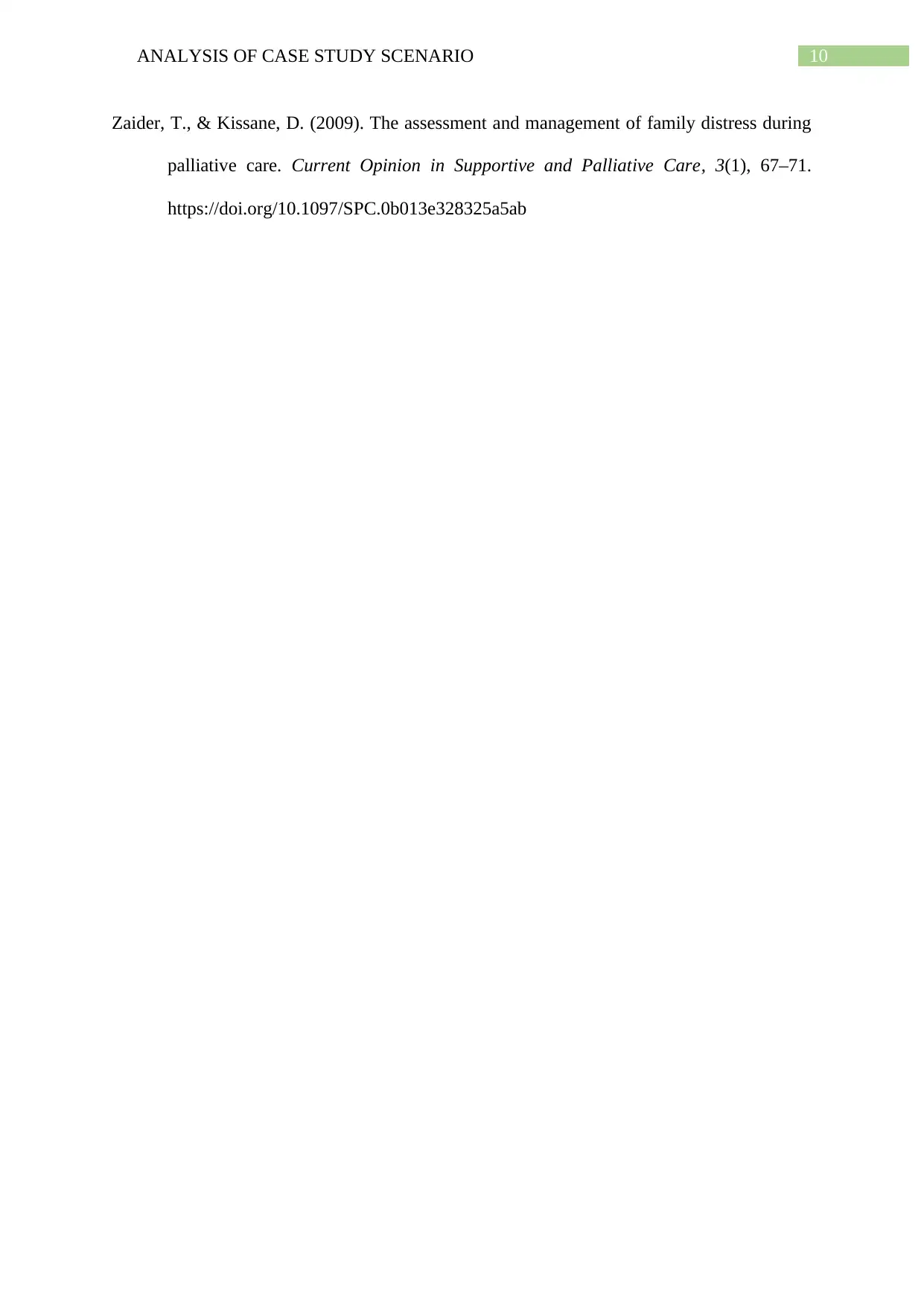
10ANALYSIS OF CASE STUDY SCENARIO
Zaider, T., & Kissane, D. (2009). The assessment and management of family distress during
palliative care. Current Opinion in Supportive and Palliative Care, 3(1), 67–71.
https://doi.org/10.1097/SPC.0b013e328325a5ab
Zaider, T., & Kissane, D. (2009). The assessment and management of family distress during
palliative care. Current Opinion in Supportive and Palliative Care, 3(1), 67–71.
https://doi.org/10.1097/SPC.0b013e328325a5ab
1 out of 11
Related Documents
Your All-in-One AI-Powered Toolkit for Academic Success.
+13062052269
info@desklib.com
Available 24*7 on WhatsApp / Email
![[object Object]](/_next/static/media/star-bottom.7253800d.svg)
Unlock your academic potential
Copyright © 2020–2025 A2Z Services. All Rights Reserved. Developed and managed by ZUCOL.





